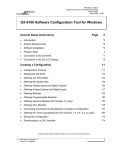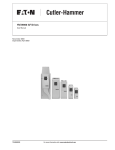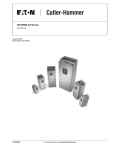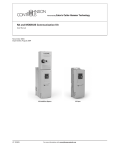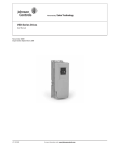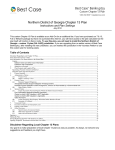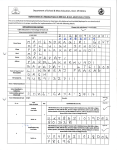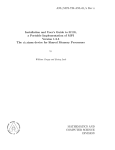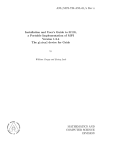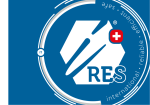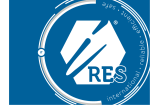Download N2 and XT BUS Communication User Manual
Transcript
Powered by Eaton’s Cutler-Hammer Technology N2 and XT BUS Communication User Manual March 2006 Supersedes January 2006 VSD IntelliPass Code No. LIT-1201829 VSD Open For more information visit: www.johnsoncontrols.com VSD Enclosed Intellipass w/DX-9100 Powered by Eaton’s Cutler-Hammer Technology N2 and XT BUS Communication User Manual March 2006 Important Notice – Please Read The product discussed in this literature is subject to terms and conditions outlined in Johnson Controls selling policies. The sole source governing the rights and remedies of any purchaser of this equipment is the relevant Johnson Controls selling policy. NO WARRANTIES, EXPRESS OR IMPLIED, INCLUDING WARRANTIES OF FITNESS FOR A PARTICULAR PURPOSE OR MERCHANTABILITY, OR WARRANTIES ARISING FROM COURSE OF DEALING OR USAGE OF TRADE, ARE MADE REGARDING THE INFORMATION, RECOMMENDATIONS AND DESCRIPTIONS CONTAINED HEREIN. In no event will Johnson Controls or Eaton Electrical Inc. be responsible to the purchaser or user in contract, in tort (including negligence), strict liability or otherwise for any special, indirect, incidental or consequential damage or loss whatsoever, including but not limited to damage or loss of use of equipment, plant or power system, cost of capital, loss of power, additional expenses in the use of existing power facilities, or claims against the purchaser or user by its customers resulting from the use of the information, recommendations and descriptions contained herein. The information contained in this manual is subject to change without notice. Cover Photo: Johnson Controls VSD Series Drives. Code No. LIT-1201829 For more information visit: www.johnsoncontrols.com i N2 and XT BUS Communication User Manual Powered by Eaton’s Cutler-Hammer Technology March 2006 Table of Contents LIST OF FIGURES . . . . . . . . . . . . . . . . . . . . . . . . . . . . . . . . . . . . . . . . . . . . . . . . . . . . . . . LIST OF TABLES . . . . . . . . . . . . . . . . . . . . . . . . . . . . . . . . . . . . . . . . . . . . . . . . . . . . . . . . SAFETY . . . . . . . . . . . . . . . . . . . . . . . . . . . . . . . . . . . . . . . . . . . . . . . . . . . . . . . . . . . . . . . Definitions and Symbols . . . . . . . . . . . . . . . . . . . . . . . . . . . . . . . . . . . . . . . . . . . . . Hazardous High Voltage . . . . . . . . . . . . . . . . . . . . . . . . . . . . . . . . . . . . . . . . . . . . . iii iii iv iv iv CHAPTER 1 — OVERVIEW . . . . . . . . . . . . . . . . . . . . . . . . . . . . . . . . . . . . . . . . . . . . . . . 1-1 Introduction . . . . . . . . . . . . . . . . . . . . . . . . . . . . . . . . . . . . . . . . . . . . . . . . . . . . . . . 1-1 Specifications . . . . . . . . . . . . . . . . . . . . . . . . . . . . . . . . . . . . . . . . . . . . . . . . . . . . . . 1-1 CHAPTER 2 — BOARD LAYOUT AND CONNECTIONS . . . . . . . . . . . . . . . . . . . . . . . . 2-1 VS-OPTNX Communication Board . . . . . . . . . . . . . . . . . . . . . . . . . . . . . . . . . . . . 2-1 CHAPTER 3 — INSTALLATION . . . . . . . . . . . . . . . . . . . . . . . . . . . . . . . . . . . . . . . . . . . . Making the Ground Connection . . . . . . . . . . . . . . . . . . . . . . . . . . . . . . . . . . . . . . . Bus Terminal Resistors . . . . . . . . . . . . . . . . . . . . . . . . . . . . . . . . . . . . . . . . . . . . . . LED Indications. . . . . . . . . . . . . . . . . . . . . . . . . . . . . . . . . . . . . . . . . . . . . . . . . . . . . Installing the VS-OPTNX Communication Board . . . . . . . . . . . . . . . . . . . . . . . . . 3-1 3-1 3-3 3-4 3-5 CHAPTER 4 — COMMISSIONING . . . . . . . . . . . . . . . . . . . . . . . . . . . . . . . . . . . . . . . . . . 4-1 Fieldbus Board Parameters . . . . . . . . . . . . . . . . . . . . . . . . . . . . . . . . . . . . . . . . . . . 4-1 RS-485 Communication Parameters. . . . . . . . . . . . . . . . . . . . . . . . . . . . . . . . . . . . 4-1 CHAPTER 5 — JOHNSON CONTROLS METASYS N2 PROTOCOL . . . . . . . . . . . . . . . 5-1 Overview . . . . . . . . . . . . . . . . . . . . . . . . . . . . . . . . . . . . . . . . . . . . . . . . . . . . . . . . . . 5-1 N2 Point Map . . . . . . . . . . . . . . . . . . . . . . . . . . . . . . . . . . . . . . . . . . . . . . . . . . . . . . 5-3 CHAPTER 6 — JOHNSON CONTROLS METASYS XT BUS PROTOCOL . . . . . . . . . . . 6-1 DX-9100 XT Bus . . . . . . . . . . . . . . . . . . . . . . . . . . . . . . . . . . . . . . . . . . . . . . . . . . . . 6-1 XT Bus Point Map. . . . . . . . . . . . . . . . . . . . . . . . . . . . . . . . . . . . . . . . . . . . . . . . . . . 6-8 CHAPTER 7 — COMMUNICATION BOARD FAULT TRACKING . . . . . . . . . . . . . . . . . . 7-1 APPENDIX A — PROCESS DATA . . . . . . . . . . . . . . . . . . . . . . . . . . . . . . . . . . . . . . . . . . A-1 Process Data OUT (Slave ➔ Master). . . . . . . . . . . . . . . . . . . . . . . . . . . . . . . . . . . . A-1 ii For more information visit: www.johnsoncontrols.com Code No. LIT-1201829 Powered by Eaton’s Cutler-Hammer Technology N2 and XT BUS Communication User Manual March 2006 List of Figures Figure 2-1: Option Board VS-OPTNX Communication Board . . . . . . . . . . . . . . . . . . . . . . Figure 3-1: Cable Stripping . . . . . . . . . . . . . . . . . . . . . . . . . . . . . . . . . . . . . . . . . . . . . . . . . . Figure 3-2: Inserting the Data Cables . . . . . . . . . . . . . . . . . . . . . . . . . . . . . . . . . . . . . . . . . Figure 3-3: Grounding the Communication Cable . . . . . . . . . . . . . . . . . . . . . . . . . . . . . . . Figure 3-4: Stripping the Communication Cables . . . . . . . . . . . . . . . . . . . . . . . . . . . . . . . Figure 3-5: Grounding the Communication Cable . . . . . . . . . . . . . . . . . . . . . . . . . . . . . . . Figure 3-6: Using Jumper X4 to Set the Bus Termination . . . . . . . . . . . . . . . . . . . . . . . . . Figure 3-7: LED Indications on the Communication Board . . . . . . . . . . . . . . . . . . . . . . . . Figure 4-1: Communication Status . . . . . . . . . . . . . . . . . . . . . . . . . . . . . . . . . . . . . . . . . . . Figure 6-1: Define VSD Analog Points by Selecting the 6AI, 2AO XT Module . . . . . . . . . . . . . . . . . . . . . . . . . . . . . . . . . . . . . . . . . . . . . . . . . . . . . . . Figure 6-2: Assign User Names and the Hardware Address for the XT Module . . . . . . . . . . . . . . . . . . . . . . . . . . . . . . . . . . . . . . . . . . . . . . . . . . . . . . . . Figure 6-3: Define VSD Digital Points by Selecting the 4DI, 4DO XT Expansion Module . . . . . . . . . . . . . . . . . . . . . . . . . . . . . . . . . . . . . . . . . . . . . . Figure 6-4: Assign User Names for the XT Expansion Module . . . . . . . . . . . . . . . . . . . . . Figure 6-5: Define All of the VSD/XT Analog Inputs as “Active” . . . . . . . . . . . . . . . . . . . Figure 6-6: Define the VSD/XT Active Analog Inputs as Noted in Table 6-1 . . . . . . . . . . . Figure 6-7: Define the VSD/XT Digital Inputs as Noted in Table 6-3 . . . . . . . . . . . . . . . . . Figure 6-8: Assign User Names and Define the VSD/XT Analog Outputs as Noted in Table 6-2 . . . . . . . . . . . . . . . . . . . . . . . . . . . . . . . . . . . . . . . . . . . . . . . . . . . Figure 6-9: Define the VSD/XT Digital Outputs as ON/OFF Type . . . . . . . . . . . . . . . . . . . Figure 6-10: Assign User Names for the VSD/XT Digital Outputs as Noted in Table 6-4 . . . . . . . . . . . . . . . . . . . . . . . . . . . . . . . . . . . . . . . . . . . . . . . . . . . Figure 6-11: After Saving the File — Download the DX and XT from the “Action” Menu . . . . . . . . . . . . . . . . . . . . . . . . . . . . . . . . . . . . . . . . . . . . . . . . . . . . . 2-1 3-1 3-1 3-2 3-2 3-3 3-3 3-4 4-3 6-2 6-2 6-3 6-3 6-4 6-4 6-5 6-5 6-6 6-6 6-7 List of Tables Table 1-1: Specifications . . . . . . . . . . . . . . . . . . . . . . . . . . . . . . . . . . . . . . . . . . . . . . . . . . . . Table 2-1: VS-OPTNX Bus Connector Signals . . . . . . . . . . . . . . . . . . . . . . . . . . . . . . . . . . . Table 3-1: Communication Board Status LED (BS) — YELLOW . . . . . . . . . . . . . . . . . . . . Table 3-2: Fieldbus Status LED (FS) — GREEN . . . . . . . . . . . . . . . . . . . . . . . . . . . . . . . . . . Table 3-3: Installing the VS-OPTNX Communication Board . . . . . . . . . . . . . . . . . . . . . . . Table 4-1: Changing the N2/XT Bus Board Commissioning Parameter Values . . . . . . . . Table 4-2: Communication Message Indications . . . . . . . . . . . . . . . . . . . . . . . . . . . . . . . . Table 5-1: Analog Inputs (AI) . . . . . . . . . . . . . . . . . . . . . . . . . . . . . . . . . . . . . . . . . . . . . . . . Table 5-2: Binary Inputs (BI) . . . . . . . . . . . . . . . . . . . . . . . . . . . . . . . . . . . . . . . . . . . . . . . . . Table 5-3: Analog Outputs (AO) . . . . . . . . . . . . . . . . . . . . . . . . . . . . . . . . . . . . . . . . . . . . . . Table 5-4: Binary Outputs (BO) . . . . . . . . . . . . . . . . . . . . . . . . . . . . . . . . . . . . . . . . . . . . . . . Table 5-5: Internal Integers (ADI) . . . . . . . . . . . . . . . . . . . . . . . . . . . . . . . . . . . . . . . . . . . . . Table 6-1: Analog Inputs (AI) . . . . . . . . . . . . . . . . . . . . . . . . . . . . . . . . . . . . . . . . . . . . . . . . Table 6-2: Analog Outputs (AO) . . . . . . . . . . . . . . . . . . . . . . . . . . . . . . . . . . . . . . . . . . . . . . Table 6-3: Digital Inputs (DI) . . . . . . . . . . . . . . . . . . . . . . . . . . . . . . . . . . . . . . . . . . . . . . . . . Table 6-4: Digital Outputs (DO) . . . . . . . . . . . . . . . . . . . . . . . . . . . . . . . . . . . . . . . . . . . . . . . Table 7-1: Communication Board Faults . . . . . . . . . . . . . . . . . . . . . . . . . . . . . . . . . . . . . . . Table 7-2: VSD Response to Faults . . . . . . . . . . . . . . . . . . . . . . . . . . . . . . . . . . . . . . . . . . . Table A-1: Fieldbus Parameters — M1 ➔ G1.9 . . . . . . . . . . . . . . . . . . . . . . . . . . . . . . . . . . Code No. LIT-1201829 For more information visit: www.johnsoncontrols.com 1-1 2-1 3-4 3-4 3-5 4-1 4-3 5-3 5-4 5-4 5-5 5-5 6-8 6-8 6-8 6-8 7-1 7-1 A-1 iii N2 and XT BUS Communication User Manual Powered by Eaton’s Cutler-Hammer Technology March 2006 Safety Definitions and Symbols WARNING This symbol indicates high voltage. It calls your attention to items or operations that could be dangerous to you and other persons operating this equipment. Read the message and follow the instructions carefully. This symbol is the “Safety Alert Symbol.” It occurs with either of two signal words: CAUTION or WARNING, as described below. WARNING Indicates a potentially hazardous situation which, if not avoided, can result in serious injury or death. CAUTION Indicates a potentially hazardous situation which, if not avoided, can result in minor to moderate injury, or serious damage to the product. The situation described in the CAUTION may, if not avoided, lead to serious results. Important safety measures are described in CAUTION (as well as WARNING). Hazardous High Voltage WARNING Motor control equipment and electronic controllers are connected to hazardous line voltages. When servicing drives and electronic controllers, there may be exposed components with housings or protrusions at or above line potential. Extreme care should be taken to protect against shock. Stand on an insulating pad and make it a habit to use only one hand when checking components. Always work with another person in case an emergency occurs. Disconnect power before checking controllers or performing maintenance. Be sure equipment is properly grounded. Wear safety glasses whenever working on electronic controllers or rotating machinery. iv For more information visit: www.johnsoncontrols.com Code No. LIT-1201829 Powered by Eaton’s Cutler-Hammer Technology N2 and XT BUS Communication User Manual March 2006 Chapter 1 — Overview Introduction The Johnson Controls VSD Series Drives powered by Cutler-Hammer® technology from Eaton’s electrical business can be controlled, monitored and programmed from a host system via Johnson Controls N2 or XT BUS communication protocols with the addition of the VS-OPTNX RS-485 Communication Option Board. If you purchase your Communication Board separate from the drive, please note that it must be installed in slot D or E on the control board of the VSD Series drive. Specifications Table 1-1: Specifications Item Specification Communication Board Connections Interface VS-OPTNX: Pluggable connector (5.08 mm) Data Transfer Method RS-485, half-duplex Communication Bus 3-wire (Twisted pair + Reference) shield optional Electrical Isolation 500V DC Communications Johnson Controls N2 Bus As described in Metasys N2 System Protocol Specification Johnson Controls XT Bus As described in Metasys System 9100 Protocol Specification Baud Rate 9600 baud Addresses 1 to 247 Environment Ambient Operating Temperature 14 to 131°F (-10 to 55°C) Storage Temperature -40 to 140°F (-40 to 60°C) Humidity <95%, non-condensing Altitude Max. 3280 ft. (1000m) Vibration 0.5G at 9 to 200 Hz Safety Standards Fulfils EN 50178 standard Certification CE, UL Code No. LIT-1201829 The N2/XT Bus is a “daisy chain” communications line. It consists of three wires for the following signals: +, –, and Common. The + and – lines carry the actual data signals. The Common line provides a reference so that each connected device is capable of electrically receiving and transmitting data by creating a common voltage reference among all the devices connected together over the communication bus. Three conductors are required. It is important that the + and – lines are twisted together, which allows most induced noise (common-mode noise) from external sources to affect both lines equally, thereby canceling the noise. In most installations, the communication bus works fine with unshielded cable. However, in noisy environments, shielded twisted wire must be used. For more information visit: www.johnsoncontrols.com 1-1 N2 and XT BUS Communication User Manual Powered by Eaton’s Cutler-Hammer Technology March 2006 1-2 For more information visit: www.johnsoncontrols.com Code No. LIT-1201829 Powered by Eaton’s Cutler-Hammer Technology N2 and XT BUS Communication User Manual March 2006 Chapter 2 — Board Layout and Connections The VS-OPTNX RS-485 Communication Board is connected to the communications bus through a 5-pin pluggable bus connector. Communication with the control board of the drive takes place through the standard Interface Board Connector (see Figure 2-1). VS-OPTNX Communication Board Yellow = RS-485 Board Status Green = Field Bus Status 1 2 3 4 5 X4 X1 Bus Connector Jumpers Interface Board Connector Figure 2-1: Option Board VS-OPTNX Communication Board Table 2-1: VS-OPTNX Bus Connector Signals Signal Connector Description SHLD 1 Shield VP 2 Supply voltage – plus 5V (not used) - 3 Receive/Transmit data – minus (N2-/RT-) + 4 Receive/Transmit data – plus (N2+/RT+) COM 5 Bus Common (REF/COM) This pin (1) can be used to bypass the cable shield to the next slave. ON X4 jumper is the 120Ω termination resistor. Set X4 jumper to ON only if the Johnson Controls N2 Protocol is selected and the drive is the last device on the network. N/A for XT bus communication. X1 jumper has no effect on VS-OPTNX board. OFF Code No. LIT-1201829 For more information visit: www.johnsoncontrols.com 2-1 N2 and XT BUS Communication User Manual Powered by Eaton’s Cutler-Hammer Technology March 2006 2-2 For more information visit: www.johnsoncontrols.com Code No. LIT-1201829 Powered by Eaton’s N2 and XT BUS Communication User Manual Cutler-Hammer Technology March 2006 Chapter 3 — Installation Making the Communication Bus and Ground Connections Terminating the Ground Wire Note: Normally, the option board has already been installed in slot D or E of the control board. It is not necessary to detach the whole board to connect the communication bus and ground the bus cable shield. Just detach the terminal block. 1. Strip about 2 in. (5 cm) of the communication cable and cut off the gray cable shield. Remember to do this for both bus cables (except for the last device). See Figure 3-1. 2. Strip the individual conductors at about 0.2 in (0.5 cm) to fit in the terminals. See Figure 3-1. Figure 3-1: Cable Stripping 3. Insert the data cables into terminals #3 (-), #4 (+) and #5 (Com.). 1 2 3 4 5 To next N2/XT Bus Device - + Com. From Previous N2/XT Bus Device Figure 3-2: Inserting the Data Cables Code No. LIT-1201829 For more information visit: www.johnsoncontrols.com 3-1 N2 and XT BUS Communication User Manual Powered by Eaton’s Cutler-Hammer Technology March 2006 Grounding by Clamping the Cable to the Converter Frame This method of grounding is the most effective, and especially recommended when the distances between the devices are relatively short. Strip the communication cable so that it can be secured to the drive frame with the grounding clamp. Figure 3-3: Grounding the Communication Cable Grounding Only One Point on the Net In this method of grounding, the shield is connected to ground only at the last device on the network. Other devices on the network just bypass the shield. 1. Strip about 2 in. (5 cm) of the communication cable and cut off the gray cable shield. 2. Leave no more than 1/4 in. (1 cm) of the cable outside the terminal block and strip the data cables at about 0.5 cm to fit in the terminals. See Figure 3-4. 1 2 3 4 5 Shield - Com. + Figure 3-4: Stripping the Communication Cables 3-2 For more information visit: www.johnsoncontrols.com Code No. LIT-1201829 Powered by Eaton’s Cutler-Hammer Technology N2 and XT BUS Communication User Manual March 2006 3. Secure the communication cable to the drive frame with the grounding clamp as shown in Figure 3-5. Figure 3-5: Grounding the Communication Cable Bus Terminal Resistors If the VS-OPTNX Option Card is programmed for N2 communication and it is the last device on the network, the bus termination must be set to ON. Use jumper X4 (set to the ON position for termination). See Figure 3-6. ON = Terminated: This is the last device on N2 bus network. OFF = Not Terminated: At least one other N2 bus network device is connected past this device. 1 2 3 4 5 X4 X1 Bus Connector Jumpers Interface Board Connector Figure 3-6: Using Jumper X4 to Set the Bus Termination Code No. LIT-1201829 For more information visit: www.johnsoncontrols.com 3-3 N2 and XT BUS Communication User Manual Powered by Eaton’s Cutler-Hammer Technology March 2006 LED Indications The two LED indicators next to the connector show the present status of the Communication Board (yellow) and the Fieldbus Module (green). Yellow = RS-485 Board Status Green = Fieldbus Status Yellow Green 1 2 3 4 5 X4 X1 Figure 3-7: LED Indications on the Communication Board Table 3-1: Communication Board Status LED (BS) — YELLOW LED is: Meaning: OFF Option board not activated ON Option board in initialization state waiting for activation command from the Variable Speed Drive (VSD) Blinking fast (once/sec) Option board is activated and in RUN state Option board is ready for external communication Blinking slow (once/5 secs) Option board is activated and in FAULT state Internal fault of option board Table 3-2: Fieldbus Status LED (FS) — GREEN 3-4 LED is: Meaning: OFF Fieldbus module is waiting for parameters from the VSD No external communication ON Fieldbus module is activated Parameters received and module activated Module is waiting for messages from the bus Blinking fast (once/sec) Module is activated and receiving messages from the bus Blinking slow (once/5 secs) Module is in FAULT state No messages from Master within the watchdog time Bus broken, cable loose or Master off-line For more information visit: www.johnsoncontrols.com Code No. LIT-1201829 Powered by Eaton’s Cutler-Hammer Technology N2 and XT BUS Communication User Manual March 2006 Installing the VS-OPTNX Communication Board Table 3-3: Installing the VS-OPTNX Communication Board Procedure Illustration 1. Remove the cable cover. 2. Open the cover of the control unit. 3. Install the VS-OPTNXC2 option board in slot D or E on the control board of the VSD. Make sure that the grounding plate (see below) fits tightly in the clamp. 1 2 3 4 5 X4 X1 Grounding Plate Code No. LIT-1201829 For more information visit: www.johnsoncontrols.com 3-5 N2 and XT BUS Communication User Manual Powered by Eaton’s Cutler-Hammer Technology March 2006 Table 3-3: Installing the VS-OPTNX Communication Board, continued Procedure Illustration 4. Make a sufficiently wide opening for your cable by cutting the cover grid as wide as necessary. 5. Close the cover of the control unit and the cable cover. 3-6 For more information visit: www.johnsoncontrols.com Code No. LIT-1201829 Powered by Eaton’s N2 and XT BUS Communication User Manual Cutler-Hammer Technology March 2006 Chapter 4 — Commissioning Fieldbus Board Parameters The VS-OPTNX RS-485 Communication board is commissioned with the control keypad by selecting values for the appropriate parameters in the Expander board menu M6. Expander Board Menu (M6) The Expander board menu makes it possible for the user, (1) to see what expander boards are connected to the control board and (2) to view and edit the parameters associated with the expander board. See the step-by-step procedure to commission the RS-485 communication board below. RS-485 Communication Parameters Table 4-1: Changing the N2/XT Bus Board Commissioning Parameter Values # Name Default Range Description 1 Communication Protocol 1 1 – N2 Bus 2 – XT Bus 3 – SA Bus Metasys N2 bus communication Metasys DX-9100 XT bus communication Metasys MS/TP BACnet Communications (future) 2 Slave Address 1 1…247 3 Communication Timeout 10 0 – OFF 1 – 300 s See Communication Timeout on Page 4-2 The parameters of every device must be set before connecting to the bus. The parameter “SLAVE ADDRESS” must be the same as programmed in the master configuration. (N2 Supervisory System or DX 9100 device.) Perform the Following Steps to Commission the RS-485 Communication Board ● From Operate Menu ● Programing Press to ● to M6 (Expander boards / G1-G5) ● to G6.4 (D:OPTCC / G1-G2) or G6.5 (E:OPTCC / G1-G2) ● G6.4.1 (Parameters P1-P3) or G6.5.1 (Parameters P1-P3) ● P6.4.1.1 or P6.5.1.1 (Comm. Protocol) N2 , or XT Note: If… G6.4 (Slot D: or E: = OPTC2) and P6.4.1.1 or P6.5.1.1 (Comm. Protocol) ModBus, or N2, the RS-485 card in the drive is the VS-OPTC2 comm. card not the VS-OPTNX comm. card. The RS-485 comm. card can be reprogrammed with the VSOPTNX firmware using the 9000X Load software available on the Johnson Controls Portal (or the Exchange website). See the notes on Page 4-2 or contact JCI Field Support Center for further information. ● P6.4.1.2 or P6.5.1.2 (Slave Address) ● P6.4.1.3 or P6.5.1.3 (Comm. Timeout) ● ● Code No. LIT-1201829 1 to 247 0 to 10 seconds To Main Menu to M8 (Operate Mode Press ) For more information visit: www.johnsoncontrols.com 4-1 N2 and XT BUS Communication User Manual Powered by Eaton’s Cutler-Hammer Technology March 2006 Procedure to Check the RS-485 Communication Software Revision ● From Operate Menu ● Programing Press to ● to M5 (System Menu / S1 – S11) ● to S5.8 (System Info / I1 – 17) ● to S5.8.6 (Expander boards / E1 – E5) ● to E5.8.6.4 (D:OPTCC / E1 – E2) ● to E5.8.6.4.2 (Program version), or E5.8.6.5.2 (Program version) or E5.8.6.5 (E:OPTCC / E1 – E2) 10610.6 = VS-OPTNX software (N2/XT) standard for VSD Series drives (No further action needed). If the comm. card revision displays … 10605.3 = VS-OPTC2 (pre-release software N2/XT) or … 10514.15 = VS-OPTC2 software (ModBus/N2) standard for Eaton drives (Perform the following steps) ! IMPORTANT The RS-485 card must be in option card slot E when running the C2toCC.exe program. 1. Run the executable file “C2toCC.exe” that is required to convert the ID of the RS-485 card so the drive will recognize the comm. card as the VS-OPTNX. 2. Download the System Software (SVX00031V015.vcn). 3. Download the JCI Application Wizard software (JCX0001V215.vcn). 4. Download the RS-485 communication card with the N2/XT protocol file (NXOPTC2_ 10610V006.vcn). Following these 5-steps will insure your drive is operating with the latest software revisions. Note: Skip Steps 2 and 4 if the VSD Series Drive order was placed on/after January 13, 2006. Communication Timeout The RS-485 communication board initiates a communication error if communication is broken for as long as defined by Communication Timeout. Communication Timeout is disabled when given the value 0. 4-2 For more information visit: www.johnsoncontrols.com Code No. LIT-1201829 Powered by Eaton’s Cutler-Hammer Technology N2 and XT BUS Communication User Manual March 2006 Communication Status To see the present status of the communication board, enter the Communication status page from the Monitor menu (G6.4.2). See Figure 4-1 and Table 4-2. Monitor V1 Comm. status V1 0.841 Good Message Count Error Message Count Figure 4-1: Communication Status Table 4-2: Communication Message Indications Messages Indications Good messages 0 – 999 Number of messages received without communication errors Error messages 0 – 64 Code No. LIT-1201829 Number of messages received with CRC or parity errors For more information visit: www.johnsoncontrols.com 4-3 N2 and XT BUS Communication User Manual Powered by Eaton’s Cutler-Hammer Technology March 2006 4-4 For more information visit: www.johnsoncontrols.com Code No. LIT-1201829 Powered by Eaton’s Cutler-Hammer Technology N2 and XT BUS Communication User Manual March 2006 Chapter 5 — Johnson Controls Metasys N2 Protocol Overview The N2 Interface provides: ● Direct control of Drive (e.g. Run, Stop, Direction, Speed reference, Fault reset) ● Full access to necessary parameters ● Monitoring of Drive status (e.g. Output frequency, Output current, Fault code) ● In stand-alone operation, or if the polling is stopped, the overridden values are released after 10 minutes. Analog Input (AI) Features All Analog Input (AI) points have the following features: ● Support Change of State (COS) reporting based on high and low warning limits. ● Support Change of State (COS) reporting based on high and low alarm limits. ● Support Change of State (COS) reporting based on override status. ● Always considered reliable and never out of range. ● Writing of alarm and warning limit values beyond the range that can be held by the drive’s internal variable will result in having that limit replaced by the “Invalid Float” value even though the message is acknowledged. The net result will be the inactivation of the alarm or warning (the same as if the original out of range value was used). ● The N2 system should be set up to disallow overriding AI points or have an alarm condition activated when a AI point is overridden. Overriding is supported from the standpoint that the “Override Active” bit will be set and the value reported to the N2 network will be the overridden value. However, the value in the drive remains unchanged. ● Overriding an AI point with a value beyond the limit allowed by the drive’s internal variable will result in an “Invalid Data” error response and the override status and value will remain unchanged. Binary Input (BI) Features All Binary Input (BI) points have the following features: ● Support Change of State (COS) reporting based on current state. ● Support Change of State (COS) reporting based on alarm condition. ● Support Change of State (COS) reporting based on override status. ● Always considered reliable. The N2 system should be set up to disallow overriding BI points or have an alarm condition activated when a BI point is overridden. Overriding is supported from the standpoint that the “Override Active” bit will be set and the value reported to the N2 network will be the overridden value. However, the value in the drive remains unchanged. Code No. LIT-1201829 For more information visit: www.johnsoncontrols.com 5-1 N2 and XT BUS Communication User Manual Powered by Eaton’s Cutler-Hammer Technology March 2006 Analog Output (AO) Features All Analog Output (AO) points have the following features: ● Support Change of State (COS) reporting based on override status. ● Always considered reliable. ● Overriding of the AO points is the method used to change a value. Overriding an AO point with a value beyond the limit allowed by the drive’s internal variable will result in an “Invalid Data” error response and the override status and value will remain unchanged. If the overridden value is beyond the drive’s parameter limit but within the range that will fit in the variable, an acknowledge response is given and the value will be internally clamped to its limit. ● An AO point override copies the override value to the corresponding drive parameter. This is the same as changing the value on the drive keypad. The value is nonvolatile and will remain in effect when the drive is turned off and back on. It also remains at this value when the N2 network “Releases” the point. The N2 system always reads the current parameter value. Note: The N2 system will not poll the AO point when it is being overridden. In this case, the N2 system will not notice a change in value if the change is made via the keypad. To avoid this scenario, set the point up as a “local control” type and release it once it has been overridden. In this way, the N2 system will monitor the value when not being overridden. Binary Output (BO) Features All Binary Output (BO) points have the following features: ● Support Change of State (COS) reporting based on override status. ● Always considered reliable. ● Overriding BO points control the drive. These points are inputs commands to the drive. When released, the drive’s internal value remains at its last overridden value. Internal Integer (ADI) Features All Internal Integer (ADI) points have the following features: 5-2 ● Do not support Change of State (COS) reporting. ● Can not be overridden. For more information visit: www.johnsoncontrols.com Code No. LIT-1201829 Powered by Eaton’s Cutler-Hammer Technology N2 and XT BUS Communication User Manual March 2006 N2 Point Map Analog Input (AI) Point Map Table 5-1: Analog Inputs (AI) NPT NPA Description Units Note AI 1 Speed Setpoint Hz 2 decimals AI 2 Output Speed Hz 2 decimals AI 3 Motor Speed Rpm 0 decimal AI 4 Load (power) % 1 decimal AI 5 Megawatt Hours MWh Total Counter AI 6 Motor Current A 2 decimal AI 7 Bus Voltage V 0 decimal AI 8 Motor Volts V 1 decimal AI 9 Heatsink Temperature °C 0 decimal AI 10 Motor Torque % 1 decimal AI 11 Operating Days Day 0 decimal AI 12 Operating Hours Hour 0 decimal AI 13 Kilowatt Hours kWh Trip Counter AI 14 Torque Reference % 1 decimal AI 15 Motor Temperature Rise % 1 decimal AI 16 PID Feedback (Process Variable) (Dependent on PID Application) " wc/Pa " wc/Pa psi/kPa °F/°C % — Duct Static — Building Static — Pressure — Temperature — Generic AI 17 Open (future use) — — AI 18 FBDataOut1Sel — 0 decimal AI 19 FBDataOut2Sel — 0 decimal 20 FBDataOut3Sel — 0 decimal AI AI 21 FBDataOut4Sel — 0 decimal AI 22 FBDataOut5Sel — 0 decimal 23 FBDataOut6Sel — 0 decimal FBDataOut7Sel — 0 decimal FBDataOut8Sel — 0 decimal AI AI AI Code No. LIT-1201829 24 25 These analog inputs are application specific. See Table A-1 on Page A-1. For more information visit: www.johnsoncontrols.com 5-3 N2 and XT BUS Communication User Manual Powered by Eaton’s Cutler-Hammer Technology March 2006 Binary Input (BI) Point Map Table 5-2: Binary Inputs (BI) NPT NPA Description 0= 1= BI 1 Ready Not Ready Ready BI 2 Run Stop Run BI 3 Direction Clockwise Counterclockwise BI 4 Faulted Not Faulted Faulted BI 5 Warning Not Warning Warning BI 6 Ref. Frequency reached False True BI 7 Motor running at zero speed False True BI 8 Digital Input Interlock False True BI 9 Bypass Mode Active False True BI 10 Digital Input Fire Mode False True BI 11 Hand Control Mode False True BI 12 Auto Control Mode False True BI 13 Control Mode OFF False True Analog Output (AO) Point Map Table 5-3: Analog Outputs (AO) NPT NPA Description Units Note AO 1 Comms Speed % 2 decimal AO 2 Current Limit A 2 decimal AO 3 Minimum Speed Hz 2 decimal AO 4 Maximum Speed Hz 2 decimal AO 5 Accel Time s 1 decimal AO 6 Decel Time s 1 decimal % 2 decimal % 2 decimal AO AO 5-4 7 8 FB PI Setpoint FB Actual Value These analog outputs are sent to the drive and require Parameter 1.1.15 St Pt source auto to be set to “Fieldbus” for AO-7 and Parameter 1.1.17 PI-Input source to be set to “Fieldbus” for AO-8. For more information visit: www.johnsoncontrols.com Code No. LIT-1201829 Powered by Eaton’s Cutler-Hammer Technology N2 and XT BUS Communication User Manual March 2006 Binary Output (BO) Point Map Table 5-4: Binary Outputs (BO) NPT NPA Description 0= 1= BO 1 Comms Start/Stop Stop Start BO 2 Comms Forward/Reverse Forward Reverse BO 3 Comms Reset Fault N/A Reset BO 4 Enable Bypass FB FixedControlWord Bit_3 Disable Enable BO 5 Activate FB.DI-3 FBFixedControlWord Bit_4 OFF ON BO 6 Activate FB.DI-4 FBFixedControlWord Bit_5 OFF ON BO 7 Activate FB.DI-5 FBFixedControlWord Bit_6 OFF ON BO 8 Activate FB.DI-6 FBFixedControlWord Bit_7 OFF ON BO 11 Pass Through RO-1 OFF ON BO 12 Pass Through RO-2 OFF ON BO 13 Pass Through DO-1 OFF ON BO 14 Activate Fire Mode OFF ON BO 15 Comms PM Setback OFF ON These binary outputs are application specific. These can be used to override DI-2 through DI-6 to the “ON” or “Activated” position. Pass Through Digital and Relay Outputs If controlling digital or relay outputs through the fieldbus, set parameters P1.3.6 – P1.3.8 “Not Used” (#0). Internal Integer (ADI) Point Mapping Table 5-5: Internal Integers (ADI) Code No. LIT-1201829 NPT NPA ADI 1 Description Units Active Fault Code — For more information visit: www.johnsoncontrols.com 5-5 N2 and XT BUS Communication User Manual Powered by Eaton’s Cutler-Hammer Technology March 2006 5-6 For more information visit: www.johnsoncontrols.com Code No. LIT-1201829 Powered by Eaton’s Cutler-Hammer Technology N2 and XT BUS Communication User Manual March 2006 Chapter 6 — Johnson Controls Metasys XT Bus Protocol DX-9100 XT Bus The Metasys DX-9100 Extended Digital Controller can be configured to provide precise Direct Digital Control (DDC) as well as Programmed Logic Control (PLC) for a variety of HVAC applications. The DX-9100 can be used as a stand-alone controller or it can be connected to a Metasys Supervisory System over the N2 communication bus. See the Metasys System 9100 Technical Guide (LIT-6364000) for the complete description of the DX-9100 operation. The XT bus communication protocol was incorporated into the VS-OPTNX communication card to allow the VSD Series Drive to operate with the Johnson Controls DX-9100 Controller as part of the Enclosed Drive package solution or to interface with a DX-9100 control panel. The interface provides the following benefits: ● Direct control of the drive through the DX-9100 controller (over the XT bus) using the standard programming tools (GX-9100 Software Configuration and the DX Commissioning Point Template Program). ● Full access to necessary parameters for control and monitoring the drive (e.g. Run Command, Speed Reference, Fault Reset, Output Frequency, Motor Speed, and Fault Codes). The DX-9100 control algorithms and input/output point assignments are defined using the GX-9100 Graphical Configuration Software. (See: GX9100 Software Configuration Guide, Lit-6364060) This software is also used to identify the “virtual” VSD Series Drive parameters, just as if you were programming the XT bus to define XT Extension Modules for the purpose of expanding I/O capability. Simply select the “6AI, 2AO” XT module from the GX-9100 program module drop-down menu (see Figure 6-1), followed by selecting the “4DI, 4DO” EXP module (see Figure 6-11). Once the XT modules are selected in the GX-9100 graphical software, refer to the XT bus point map (Tables 6-1 to 6-4) for the XT input/output definition that aligns with the VSD Series Drive parameters. See Tables 14 and 15 in the N2 Integration with the NAE Technical Bulletin (LIT-1201683) for complete details on mapping DX-9100 points to NAE objects (including tag names, item descriptions, which points are commandable, etc.). The “Hardware Address” assigned to the XT Extension Module is the “Slave Address” that will be entered when programming the RS-485 communication parameters in the VSD Series drive (see Chapter 4 – Commissioning). Note: A sample DX-9100/XT configuration file of the virtual XT-9100 extension module and XP-9102/XP-9104 expansion modules is available for download from the Johnson Controls portal website at my.johnsoncontrols.com under > Products: Variable Speed Drives. On ABCS Exchange, visit Exchange Site > Products > Product Families > Variable Speed Drives. This will provide the end-user with a starting point for configuring the DX-9100/XT application using the GX9100 Graphical Programming Tool. Code No. LIT-1201829 For more information visit: www.johnsoncontrols.com 6-1 N2 and XT BUS Communication User Manual Powered by Eaton’s Cutler-Hammer Technology March 2006 Figure 6-1: Define VSD Analog Points by Selecting the 6AI, 2AO XT Module Figure 6-2: Assign User Names and the Hardware Address for the XT Module 6-2 For more information visit: www.johnsoncontrols.com Code No. LIT-1201829 Powered by Eaton’s Cutler-Hammer Technology N2 and XT BUS Communication User Manual March 2006 Figure 6-3: Define VSD Digital Points by Selecting the 4DI, 4DO XT Expansion Module Figure 6-4: Assign User Names for the XT Expansion Module Code No. LIT-1201829 For more information visit: www.johnsoncontrols.com 6-3 N2 and XT BUS Communication User Manual Powered by Eaton’s Cutler-Hammer Technology March 2006 Figure 6-5: Define All of the VSD/XT Analog Inputs as “Active” Figure 6-6: Define the VSD/XT Active Analog Inputs as Noted in Table 6-1 6-4 For more information visit: www.johnsoncontrols.com Code No. LIT-1201829 Powered by Eaton’s Cutler-Hammer Technology N2 and XT BUS Communication User Manual March 2006 Figure 6-7: Define the VSD/XT Digital Inputs as Noted in Table 6-3 Figure 6-8: Assign User Names and Define the VSD/XT Analog Outputs as Noted in Table 6-2 Code No. LIT-1201829 For more information visit: www.johnsoncontrols.com 6-5 N2 and XT BUS Communication User Manual Powered by Eaton’s Cutler-Hammer Technology March 2006 Figure 6-9: Define the VSD/XT Digital Outputs as ON/OFF Type Figure 6-10: Assign User Names for the VSD/XT Digital Outputs as Noted in Table 6-4 6-6 For more information visit: www.johnsoncontrols.com Code No. LIT-1201829 Powered by Eaton’s Cutler-Hammer Technology N2 and XT BUS Communication User Manual March 2006 Figure 6-11: After Saving the File — Download the DX and XT from the “Action” Menu Code No. LIT-1201829 For more information visit: www.johnsoncontrols.com 6-7 N2 and XT BUS Communication User Manual Powered by Eaton’s Cutler-Hammer Technology March 2006 XT Bus Point Map Analog Input (AI) Point Map Table 6-1: Analog Inputs (AI) NPT/NPA Description Units Default XTxAI1 Speed Setpoint % N.A. XTxAI2 Output Speed % N.A. XTxAI3 Frequency Output Hz N.A. XTxAI4 Motor Speed RPM N.A. XTxAI5 Fault Code XTxAI6 Not Used N.A. Analog Output (AO) Point Map Table 6-2: Analog Outputs (AO) NPT/NPA Description Units Default XTxAO7 Reference (Speed) Command % 20% XTxAO8 Not Used Digital Input (DI) Point Map Table 6-3: Digital Inputs (DI) NPT/NPA Description Units Note XTxDI1 Drive Running On/Off 1=On=Drive Running XTxDI2 Drive Faulted On/Off 1=On=Faulted XTxDI3 Hand (Manual) Mode On/Off 1=On=Hand Mode XTxDI4 Auto Mode On/Off 1=On=Auto Mode Digital Output (DO) Point Map Table 6-4: Digital Outputs (DO) NPT/NPA Description Units Note XTxDO1 Run (Start) Command On/Off 1=On=Run XTxDO2 Reset Fault Command On/Off 1=On=Reset Fault XTxDO3 Bypass Mode On/Off 1=On=Bypass Enable XTxDO4 Not Used Default = 0. Requires the “Run” Command = On to activate the bypass command. The Reset Fault DO point must be commanded to the OFF state after each occurrence of resetting a fault condition. 6-8 For more information visit: www.johnsoncontrols.com Code No. LIT-1201829 Powered by Eaton’s N2 and XT BUS Communication User Manual Cutler-Hammer Technology March 2006 Chapter 7 — Communication Board Fault Tracking The table below presents the faults related to System Level errors. For more fault code information, see also VSD Series User Manual (Fault Tracking Section). Table 7-1: Communication Board Faults Fault Code Fault Possible cause Possible solutions 37 Device change Option board changed Reset 38 Device added Option board added Reset 39 Device removed Option board removed Reset 40 Device unknown Unknown option board Check the installation. If installation is correct contact Johnson Controls Technical Support. 53 Fieldbus fault The data connection between the Modbus Master and the Modbus option board is broken Check the installation. If installation is correct contact Johnson Controls Technical Support. 54 Slot fault Defective option board or slot Check the board and slot. Contact Johnson Controls Technical Support. You can define with parameters how the AFD shall react to certain faults: Table 7-2: VSD Response to Faults Code No. LIT-1201829 Code Parameter Min. Max P2.7.22 Response to fieldbus fault 0 P2.7.23 Response to slot 0 fault Unit Step Default Note 3 1 0 0=No response 1=Warning 2=Fault,stop acc. to 2.4.7 3=Fault,stop by coasting 3 1 0 0=No response 1=Warning 2=Fault,stop acc. to 2.4.7 3=Fault,stop by coasting For more information visit: www.johnsoncontrols.com 7-1 N2 and XT BUS Communication User Manual Powered by Eaton’s Cutler-Hammer Technology March 2006 7-2 For more information visit: www.johnsoncontrols.com Code No. LIT-1201829 Powered by Eaton’s Cutler-Hammer Technology N2 and XT BUS Communication User Manual March 2006 Appendix A — Process Data Process Data OUT (Slave ➔ Master) The fieldbus master can read the VSD’s actual values using process data variables. Remote Input, Generic PI, Duct Static, Building Static, Pressure Control and Temperature Control Applications use process data as follows: Table A-1: Fieldbus Parameters — M1 ➔ G1.9 Parameter P1.9.1 FB Data Out1 Sel 0 10000 1 1001 P1.9.2 FB Data Out2 Sel 0 10000 5 1002 P1.9.3 FB Data Out3 Sel 0 10000 8 1003 P1.9.4 FB Data Out4 Sel 0 10000 7 1004 P1.9.5 FB Data Out5 Sel 0 10000 9 1005 P1.9.6 FB Data Out6 Sel 0 10000 20 1006 Min. Max. Unit Default ID Number Description Code Fieldbus process data output 1 selection. Default = Actual Speed Fieldbus process data output 2 selection. Default = Motor Current Fieldbus process data output 3 selection. Default = Motor Voltage Fieldbus process data output 4 selection. Default = Motor Power Fieldbus process data output 5 selection. Default = DC-Link Voltage Fieldbus process data output 6 selection. Default = Application Status Word (Variable:ApplStatusWord) b0 = Drive Ready b1 = Run Enable b2 = Drive Running b3 = Drive Reversing b4 = General Fault b5 = General Warning b6 = Jogging speed (PM Setback) active b7 = Motor Regulator active b8 = Output speed supervision indication b9 = Setpoint speed supervision indication b10 = HAND Control indication b11 = AUTO Control indication b12 = D-IN Firemode b13 = Damper control signal b14 = Bypass mode status indication b15 = Bypass running ID number of parameter or variable to be sent over fieldbus. ID 1 – 20 are Monitoring values, Menu 7 (M7). Code No. LIT-1201829 For more information visit: www.johnsoncontrols.com A-1 N2 and XT BUS Communication User Manual Powered by Eaton’s Cutler-Hammer Technology March 2006 Table A-1: Fieldbus Parameters — M1 ➔ G1.9 , continued Parameter P1.9.7 FB Data Out7 Sel 0 10000 18 1007 P1.9.8 FB Data Out8 Sel 0 10000 19 1008 Min. Max. Unit Default ID Number Description Code Fieldbus process data output 7 selection. Default = Active Fault Code Fieldbus process data output 8 selection. Default = Active Warning Code ID number of parameter or variable to be sent over fieldbus. ID 1 – 20 are Monitoring values, Menu 7 (M7). The VSD Series applications have a selector parameter for every Process Data. The monitoring values and drive parameters can be selected using the ID number (see VSD Series Drives User Manual, Lit-1201828, Chapter 15 – Description of Parameters, for further definitions). A-2 For more information visit: www.johnsoncontrols.com Code No. LIT-1201829 Powered by Eaton’s Controls Group 507 E. Michigan Street P.O. Box 423 Milwaukee, WI 53201 Cutler-Hammer Technology © 2006 Johnson Controls All Rights Reserved Printed in USA Code No. LIT-1201829/CPG www.johnsoncontrols.com March 2006








































